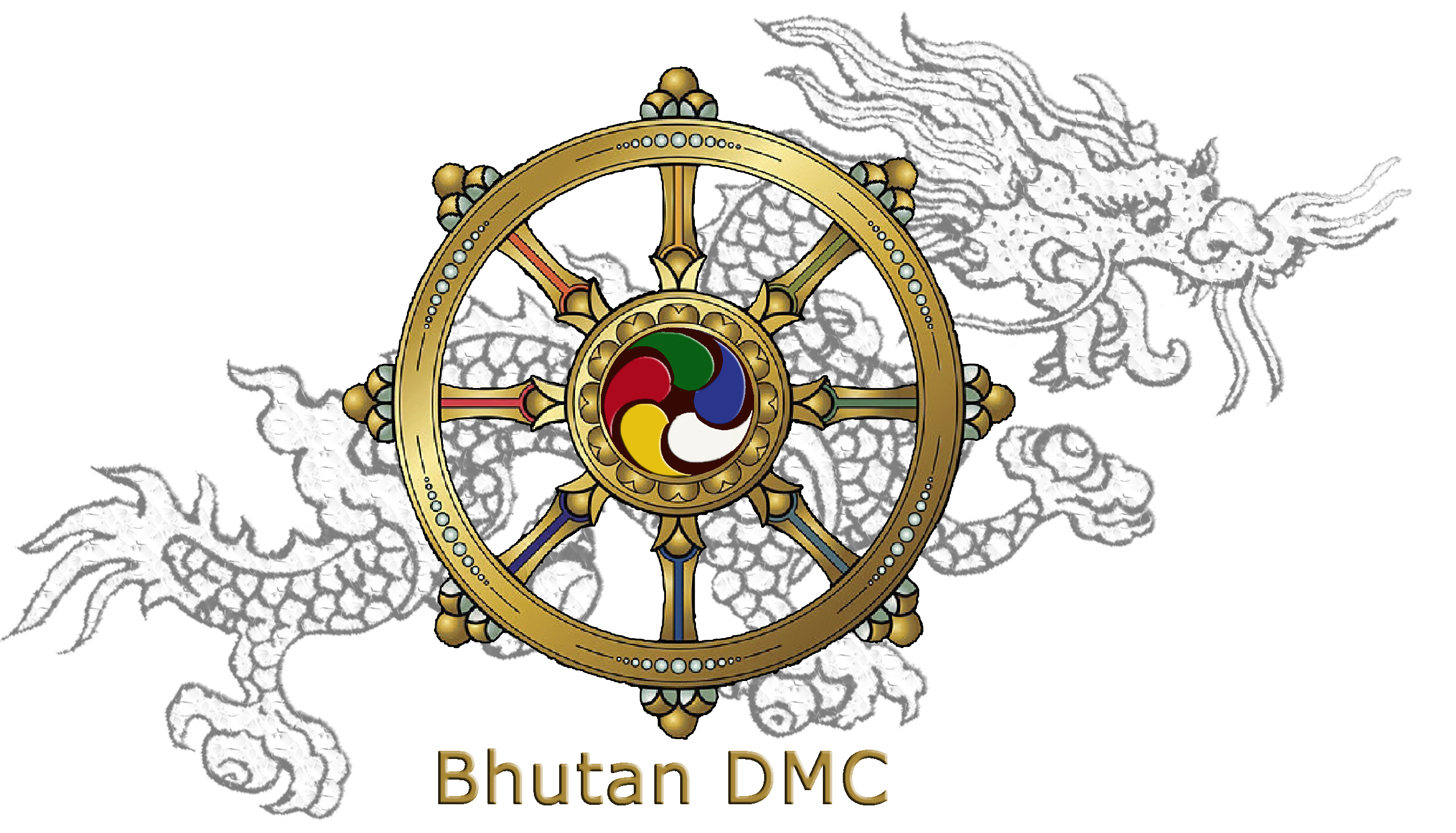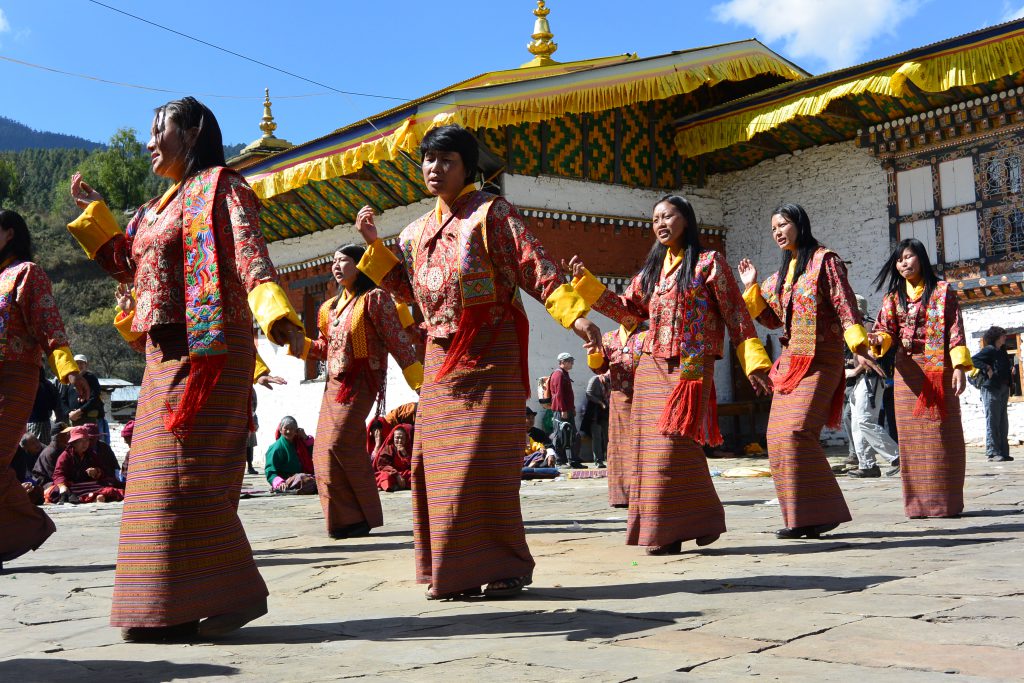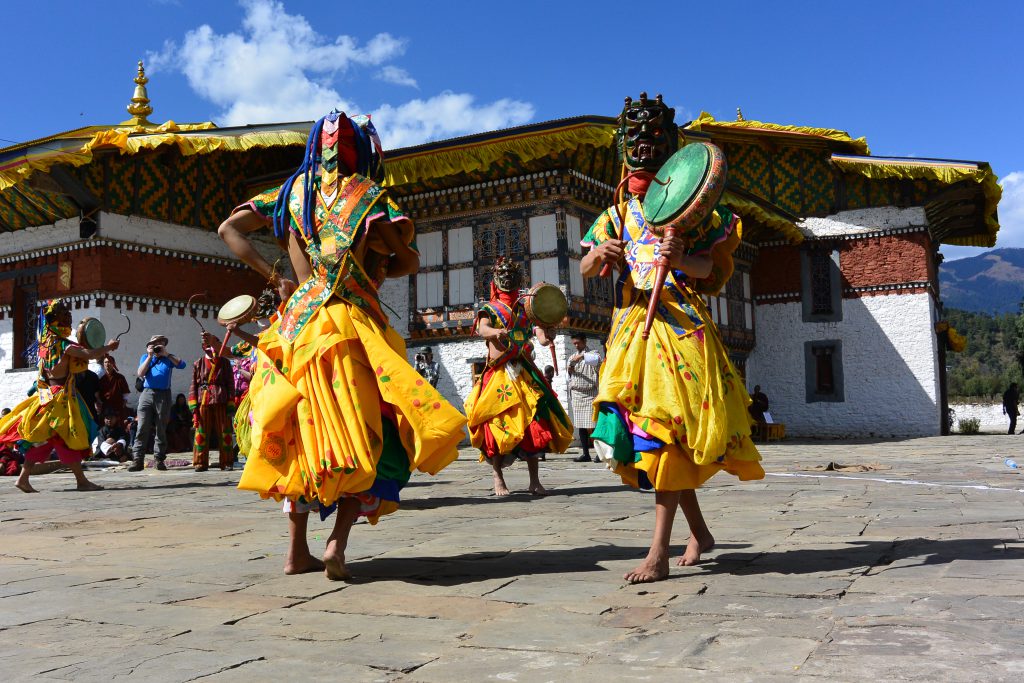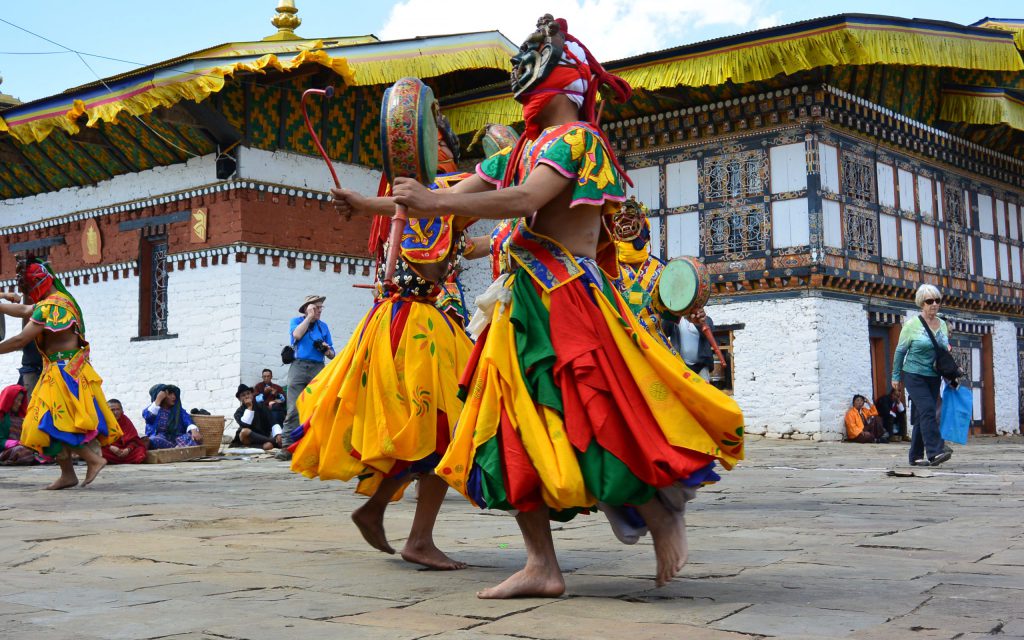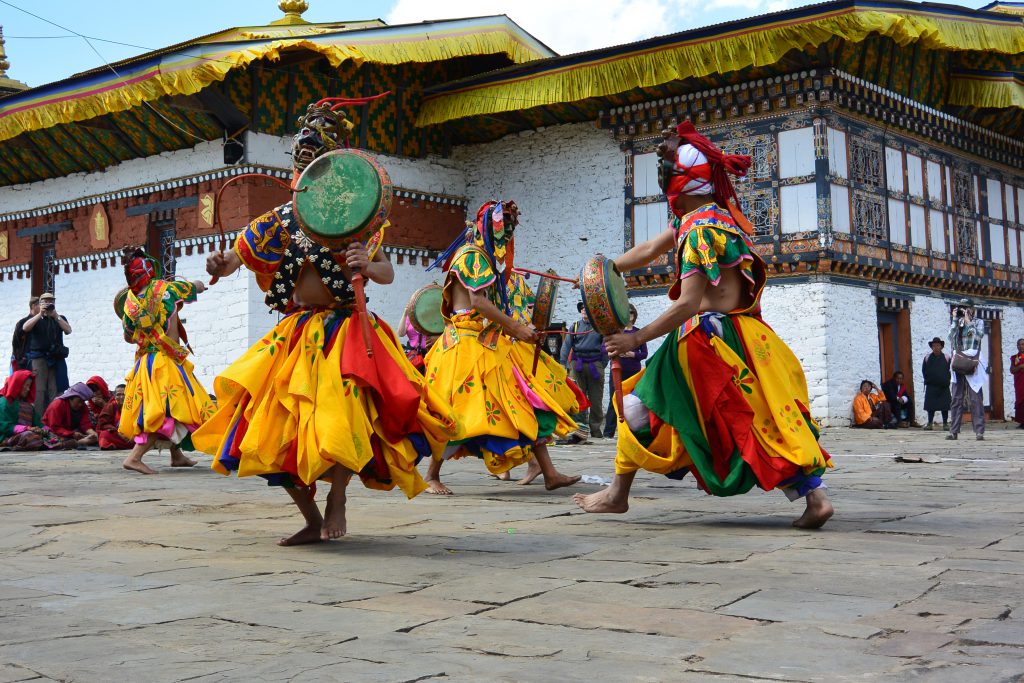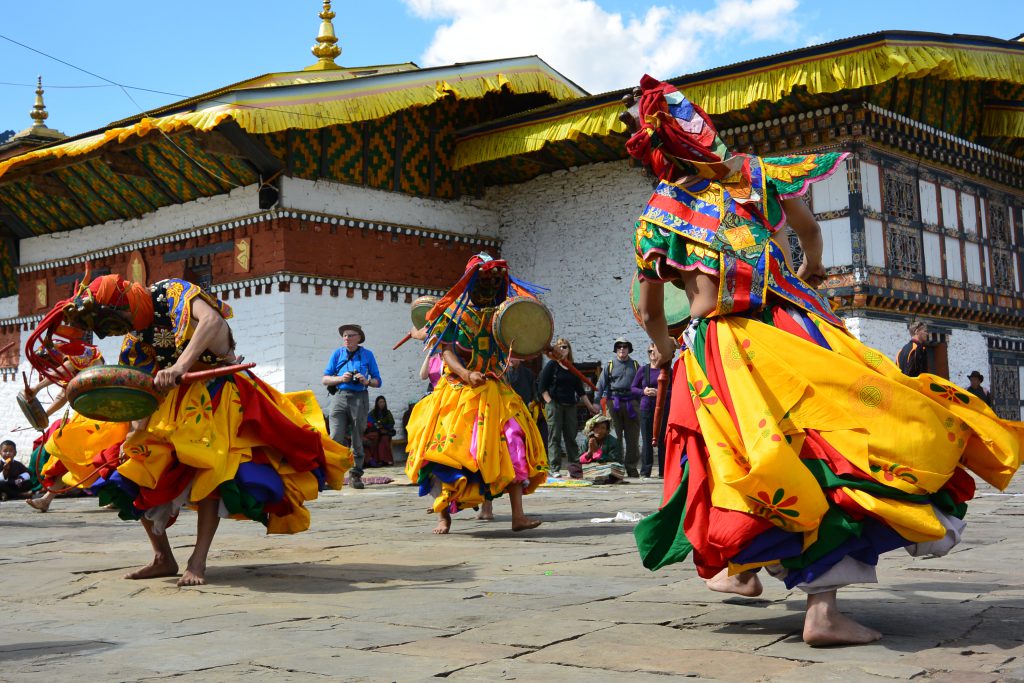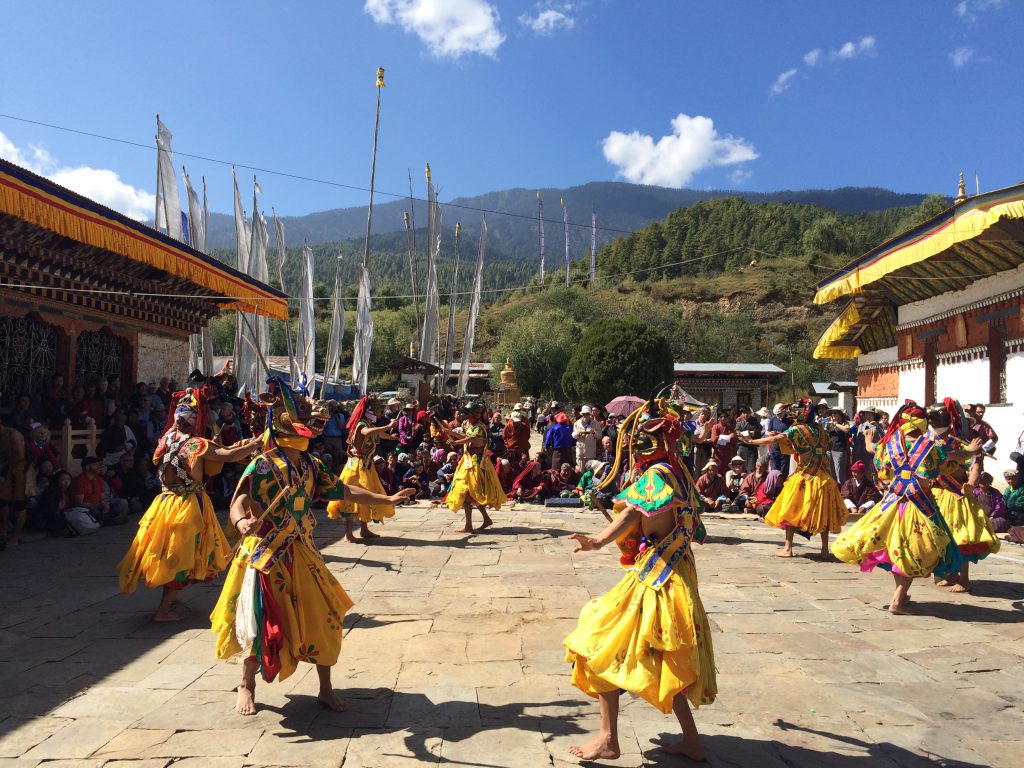Jambay Lhakhang, is one of the oldest temples in the kingdom, founded by Songtsen Gampo, a Tibetan King in the 7th century AD. The King was destined to build 108 temples known as Thadhul- Yangdhul (temples on and across the border) in a day to subdue the demoness that was residing in the Himalayas. This temple is one of the two of the 108 built in Bhutan. A second is located in Paro, the Kichu lhakhang also built on the same day. One of the most spectacular festivals in the country, called Jambay lhakhang Drup is hosted here with a dual purpose and agenda.
Coinciding Jambay Lhakhang Drup dates, another annual festival is held at the Prakhar Lhakhang, in the Chumi Valley of Bumthang, which is about half an hour drive from Chamkhar town. Built in 16th century, it is main temple of the village and located about 10 minutes’ walk from the road.
Day 1
Arrive Paro by Flight & Transfer to Thimphu
The flight to Paro is one of the most spectacular in entire Himalayas. Flying along the Himalayan range from Kathmandu or over Himalayan foothills, the journey offers fascinating views and an exciting descent into the Kingdom. Bhutan’s first gift to you as you disembark from the aircraft will be cool, clean fresh mountain air. After immigration formalities and baggage collection, you will be met by our representative, and afterwards drive to Thimphu, the capital town of Bhutan
On arrival, in Thimphu check-into the hotel. The capital town of Bhutan and the centre of government, religion and commerce, Thimphu is a unique city with unusual mixture of modern development alongside ancient traditions. With the population of about 1,00,000 it is perhaps still the world’s only capital city without a traffic light.
Later in the day take an exploratory walk around local market place located a few minutes’ walk from hotels. Or take a walk to local craft Bazar recently established under patronage of Department of cottage & small industry and in collaboration with the Department of culture, Tourism council and the Department of agriculture marketing and cooperatives, this market offers genuine Bhutanese arts & crafts thus contributing in promotion, protection and preservation of traditional arts.
Overnight at the hotel in Thimphu. (Altitude 2,320m)
Day 2
Thimphu
After breakfast, proceed for the guided tour of city’s main attractions that includes:
Textile Museum: It is worth a visit to get to know the living national art of weaving. Exhibitions introduce the major weaving techniques, styles of local dress and textiles made by women and men.
Institute for Zorig Chusum: Commonly known as Arts & Crafts School or Painting School, the Institute offers a six-year course on the 13 traditional arts and crafts of Bhutan. On a visit, one can see students learning the various skills taught at the school.
Changangkha Lhakhang: It is a fortress like temple and monastic school perched on a ridge above Thimphu, south of Motithang. The temple was established in 12th century on a site chosen by Lama Phajo Drugom Shigpo, who came from Tibet. The central statue here is Chenrezig in a manifestation with 11 heads. From temple courtyard, there is fascinating view of Thimphu valley.
Simply Bhutan Museum: The newly commissioned museum depicts the ancient Bhutanese architecture which is being lost to modernization. The uniqueness of the structure is in its composition of the materials used. The structure is built reusing old timber, window and door frames and other items from traditional and old demolished houses. The best part is the portrayal of the age-old lifestyles of the Bhutanese people.
Lunch followed by city tour that includes:
Memorial Chorten: The stupa built in the memory of Bhutan’s third King, His Late Majesty, King Jigme Dorji Wangchuk, who is popularly regarded as Father of modern Bhutan. The paintings and statues inside the monument provide a deep insight into Buddhist philosophy.
Buddha Point (Kuensel Phodrang). Located at a short drive from Thimphu city centre, visitors can get a good overview of the Thimphu valley from the Buddha point (Kuensel Phodrang). You can pay your obeisance and offer prayers to the Buddha, the largest statue in the country and then walk around and take a glimpse of the valley.
Conclude the tour of the day with a visit of Trashichhoedzong, ‘fortress of the glorious religion’. This is the center of government and religion, site of monarch’s throne room and seat of Je Khenpo or Chief Abbot. Built in 1641 by the political and religious unifier of Bhutan, Shabdrung Ngawang Namgyal, it was reconstructed in 1960s in traditional Bhutanese manner, without nails or architectural plans.
Overnight at the hotel in Thimphu. (Altitude 2,320m)
Day 3
Thimphu – Gangtey (150 km, approx. 5-hour drive)
After breakfast enjoy a dramatic drive over the high mountain pass of Dochu La (3,088m) and on to the Phobjikha Valley passing through dense forests and oak, rhododendron tress.
After checking into hotel, explore Gangtey village and Phobjikha valley on foot.
The valley of Gangtey is one of the most beautiful spots in Bhutan. The surprise of finding such a wide, flat valley without any trees after the hard climb through dense forests is augmented by an impression of vast space, and extremely rare experience in Bhutan where most of the valleys are tightly enclosed. A few kilometers beyond the Gangtey Monastery, on the valley floor lies the village of Phobjikha. This place is the winter home of black necked cranes that migrate from the arid plains in the north to pass winter in milder and lower climate. Phobjikha, at an altitude of 2900 m, falls under the district of Wangduephodrang and lies on the periphery of the Black Mountain National Park.
Explore Phobjikha valley for Black Necked Cranes.
Later visit Gangtey Gompa. Perched on a small hill that rises from the valley floor, the Gangtey Monastery is the only Nyingmapa monastery on the western side of the Black Mountain’s and also the biggest Nyingmapa monastery in Bhutan. The Monastery is surrounded by a large village inhabited mainly by the families of the 140 Gomchens who take care of the Monastery.
Overnight at the hotel in Gangtey. (Altitude 3,000m)
Day 4
Gangtey – Bumthang (153km, approx. 5-hour drive)
Morning after breakfast drive to Bumthang via Trongsa.
The drive to Trongsa crosses Pelela pass (3,300 m), the traditional boundary between east and west. The pass is marked by a large prayer flag and the ground is covered with high altitude dwarf bamboo. Stop en route at Chendbji Chorten, the stupa built in 18th century by a Lama named Shida. It is Nepalese in style with eyes painted at four cardinal points.
Trongsa town, perched on steep slopes above a river gorge, forms the central hub of the nation and is the place from where attempts at unifying the country were launched. The landscape around Trongsa is spectacular.
After lunch in Trongsa, proceed to visit Trongsa Dzong, built in 1648 it was the seat of power over central and eastern Bhutan. Both the first and second Kings of Bhutan ruled the country from this ancient seat.
Then continue drive to Bumthang across Yutong-la pass (3,400m/ 11,155 ft). The road winds steeply up to the pass from Trongsa, then runs down through coniferous forest into a wide, open cultivated valley known as the Chumey valley.
Take a short stop at Chumey, a wide fertile valley where wheat, barley, potatoes and buckwheat are cultivated. Chumey is particularly known for its famous wool weaving called ‘Bumthang Yathra’. Visit Yathra weaving centre, enjoying tea / coffee with weaving family.
On arrival in Bumthang, check in to the hotel.
Overnight at the hotel in Bumthang. (Altitude 2600m)
Day 5
Bumthang
Bumthang is the general name given to combination of four valleys – Chumey, Choekhor, Tang and Ura with altitude varying from 2,600m to 4,000m. It is home to many of prominent Buddhist temples and monasteries.
After breakfast, witness Jambay Lhakhang Drup. Jambay Lhakhang, is one of the oldest temples in the kingdom, founded by Songtsen Gampo, a Tibetan King in the 7th century AD. The king was destined to build 108 temples known as Thadhul- Yangdhul (temples on and across the border) in a day to subdue the demoness that was residing in the Himalayas. This temple is one of the two of the 108 built in Bhutan. A second is located in Paro, the Kichu lhakhang also built on the same day. The festival is hosted here with a dual purpose and agenda. Firstly, it is a tribute to the honour of Guru Rinpoche, a saint who introduced Tantric form of Buddhism in the country and secondly, this festival commemorates the establishment of Jambay Lhakhang (temple) in the 8th century. During the festival, variety of traditional and mask dances are performed and each dance bear significance meaning. However, the highlight of Jambay Lhakhang Drup remains the fire ceremony named ‘Mewang’ and the religious dance known as ‘Tercham’. Apart from these, the other activities include- a famous drumbeat dance, a clown dance called Dola Pangtoy Shazam, Raksha Mangcham (a dance symbolizing life after death) and many more. With the proceedings of the events, this festival captures the attention of the onlookers and create a magnificent spectacle.
Later in the afternoon visit to Kurje Lhakhang, consisting of three temples. The one on the right was built in 1652 on the rack face where Guru meditated in the 8th century. Second temple is built on the site of a cave containing a rock with the imprint of Guru’s body and is therefore considered the most holy. The third temple was built in 1990s by Ashi Kesang, the Queen Mother. These three temples are surrounded by a 108 chorten wall.
Afterwards drive to Tamshing Lhakhang, the temple founded in 1501 by Terton Pema Lingpa, the re-incarnation of Guru Padsambhava. The monastery has very ancient religious paintings like 1,000 Buddhas and 21 Taras (female form of Buddhistava). The temple was restored at the end of the 19th century.
Overnight at the hotel in Bumthang. (Altitude 2,600m)
Day 6
Bumthang
After breakfast, drive to witness Prakhar Duchhoed. The annual festival is held at the Prakhar Lhakhang, in the Chumi Valley of Bumthang, which is about half an hour drive from Chamkhar town. Built in 16th century, it is main temple of the village and located about 10 minutes’ walk from the road. It is said that Langurs helped in making this Lhakhang and humans use to carry on work during the day while the monkeys would continue the work at night, hence the name ‘Prakhar’, which means ‘White Monkey’. The festival lasts for 3 days from the 16th to the 18th of the ninth lunar month in the Bhutanese calendar. The festival is celebrated to honor Lama Thukse Dawa, one of the sons of the 15th century Buddhist master, Terton Pema Lingpa, who was one of the greatest Buddhist masters to be ever born in Bhutan. Several kinds of mask dances are performed during the festival.
Later in the afternoon visit Jakar Dzong. Founded by great grandfather of the first Shabdrung, the Dzong was initially built as a monastery in 1549. It was upgraded after the Shabdrung had firmly established his power in 1646. The Dzong is now used as administrative centre for Bumthang valley and houses the regional monk body.
Overnight at the hotel in Bumthang. (Altitude 2,600m)
Day 7
Bumthang – Punakha & Wangdue (215km, approx. 7-hour drive)
After breakfast, depart for the drive to Punakha.
En route visit Ta Dzong, recently opened fort in Trongsa. The Ta Dzong, a cylindrical stone structure rising five stories, was built in 1652 by Chogyal Minjur Tempa. After more than 350 years, it has been resurrected into a classy museum, that represents a tasteful blend of tradition and modernity.
Evening at leisure in Punakha & Wangdue towns.
Overnight at Hotel in Punakha & Wangdue. (Altitude 1300m)
Day 8
Punakha & Wangdue
After breakfast, visit Punakha Dzong or (Palace of Great Happiness), built at the junction of the Phochu and Mochu rivers in 1637 by Shabdrung Ngawang Namgyal. This majesticdzong served as both the religious and the administrative center of Bhutan in the past. It measures some 600 by 240 feet and has a six-story, gold-domed tower. Inside are courtyards and religious statuary that hint at the depth of history and spiritual tradition embodied here. Your guide will illuminate your understanding of this intricate culture that is exotic to us, though long established here.
Then a short excursion to Chimi Lhakhang.
The Chimi Lhakhang, situated on a hillock in the centre of the valley, also known as the temple of fertility. It is widely believed that couples who do not have children and wanting one, if they pray at this temple, they are usually blessed with a child very soon. The trail leads across rice fields to the tiny settlement of Pana, meaning ‘field’. A walk through the village near the temple will give you rare glimpses into the daily life and lifestyle of the villagers.
Post lunch, excursion to Talo village, which is scattered along the hill slopes and known for its cleanliness and hygiene among Punakha villages. Talo is the seat of the mind incarnations of the Zhabdrung. Talo Sangnacholing Dzong is built on a plateau and has majestic view of surrounding villages. The beautiful farmhouses of the village have its own flower gardens, and, on the hill, slope corns and sweet peas are grown in abundance. Spend time at Nobgang and Talo villages visiting farmhouses and meeting families, experiencing Bhutanese rural life.
Overnight at the hotel in Punakha & Wangdue. (Altitude 1,300m)
Day 9
Punakha & Wangdue – Paro (125 km, approx. 4-hour drive)
After breakfast, drive to Paro along scenic highway. En route visit Simtokha Dzong, the oldest fortress of the country built in 1627 which now houses the School for Buddhist studies.
On arrival in Paro, check into the hotel.
After lunch, proceed to visit Ta Dzong, originally built as Watchtower, which now houses National Museum. The extensive collection includes antique thangkha paintings, textiles, weapons & armour, household objects and a rich assortment of natural and historic artifacts.
Ta Dzong visit immediately followed by a short walk down the trail to visit Rinpung Dzong (Paro Dzong), meaning (“fortress of the heap of jewels”), which has a long and fascinating history. Along the wooden galleries lining the inner courtyard are fine wall paintings illustrating Buddhist lore such as four friends, the old man of long life, the wheel of life, scenes from the life of Milarepa, Mount. Sumeru and another cosmic Mandala.
Overnight at the hotel in Paro. (Altitude 2,280m)
Day 10
Paro
After breakfast, embark on an excursion to Taktshang Monastery or Tiger’s Nest (approx. 5 hours round trip walk): It is one of the most famous of Bhutan’s monasteries, perched on the side of a cliff 900m above the Paro valley floor. It is said that Guru Rinpoche arrived here on the back of a tigress and meditated at this monastery and hence it is called ‘Tiger’s Nest’. This site has been recognised as a most sacred place and visited by Shabdrung Ngawang Namgyal in 1646 and now visited by all Bhutanese at least once in their lifetime.
Late afternoon, drive end of the Valley to the base of Drukgyel Dzong, a 17th century fortress burned down in the early 50s. Here we will also see the beautiful typical farmhouse. Bhutanese farmhouses are very colorful, decorative and traditionally built without the use of single nail. The majority of the population of Bhutan continues to live as it has for centuries – in small isolated farms and hamlets, surrounded by terraced fields of rice, maize and buckwheat.
While driving to Paro town, stop en route at the 7th century Kyichu Lhakhang, one of the 108 temples built in the Himalayas by Tibetan King, Songtsen Gampo. The building of this temple marks the introduction of Buddhism in Bhutan.
Overnight at the hotel in Paro. (Altitude 2,280m)
Day 11
Depart Paro
After breakfast, transfer to the airport for flight to onward destination.
Image Gallery
